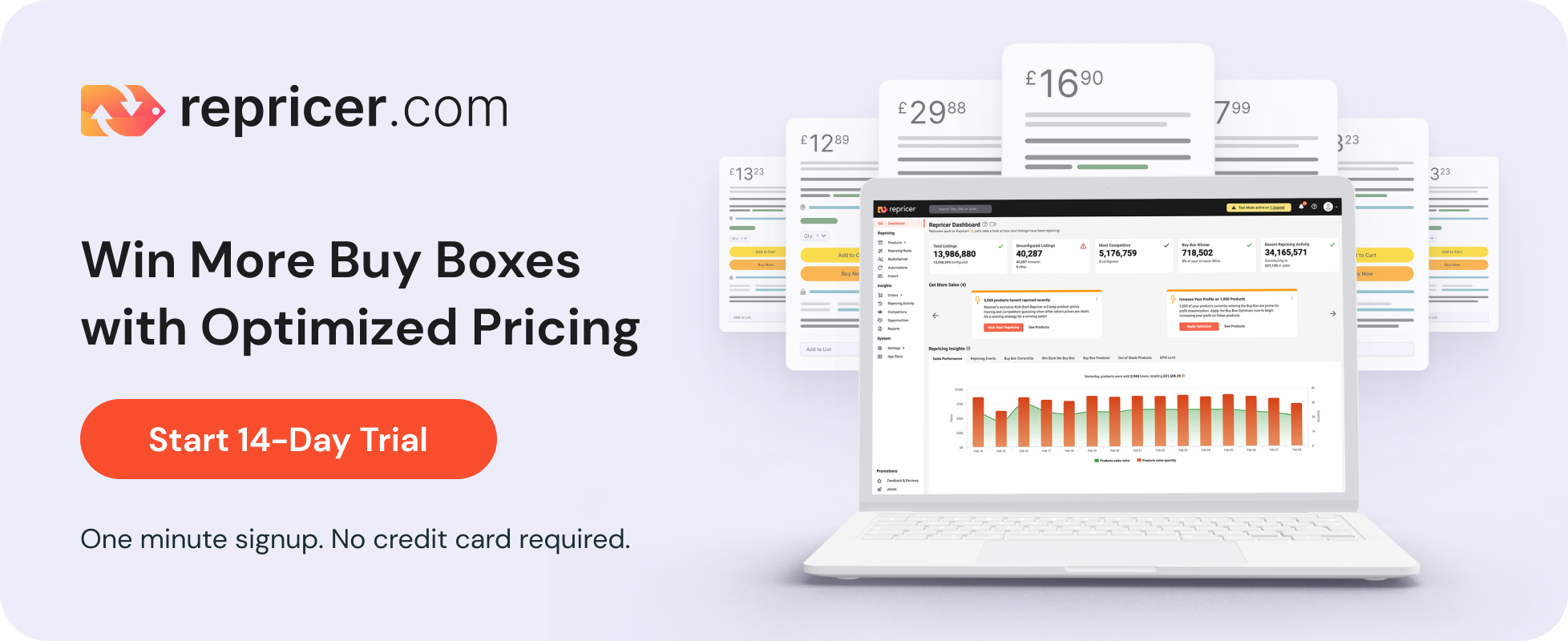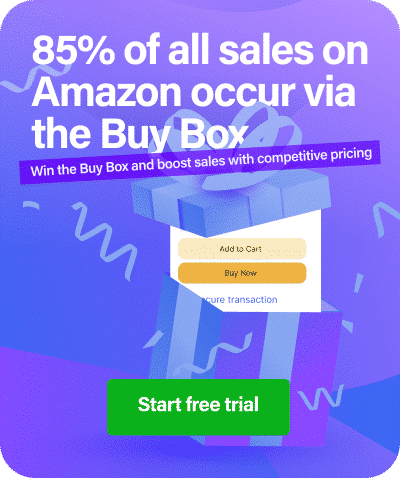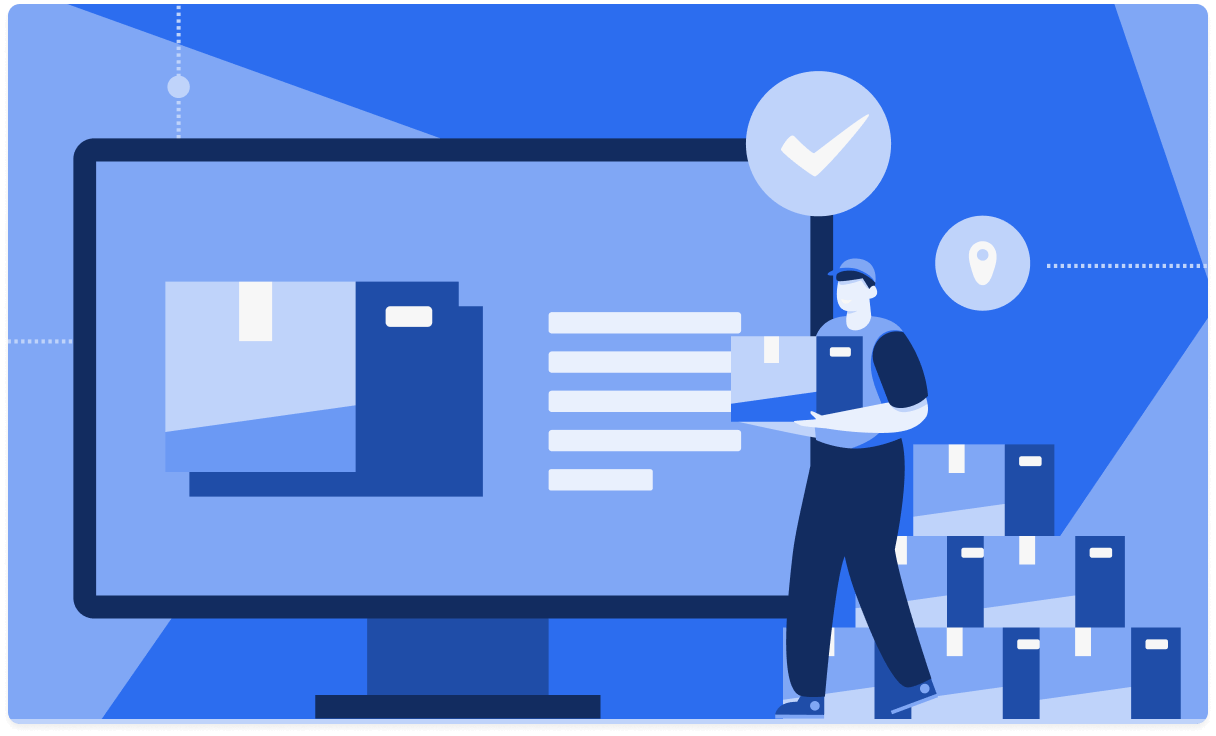Amazon’s steady march toward global domination shows no signs of slowing. According to Companies Market Cap, Amazon’s market capitalisation stands at over $940 billion.
The stats don’t lie and it’s more important than ever to include Amazon in your eCommerce strategy — but just having a presence on the platform isn’t going to win you more business.
With millions of third-party merchants on the marketplace — many of them selling the same thing, all vying for a piece of the pie — standing out to shoppers requires more than great merchandise or low prices. In fact, most people won’t even see your products unless they appear in the Buy Box.
Indeed, that small “Add to Basket” button has become one of the biggest battlegrounds in online retail and every online seller wants to win it, selected by Amazon’s super-secret algorithm to be pushed to the front of the queue where the chances of ringing up a sale skyrocket.
Thankfully, bagging the Amazon Buy Box is not as hard as it may seem. Follow the steps outlined in this guide and you’ll be in tip-top shape to score.
1. What is the Amazon Buy Box
2. Why winning the Amazon Buy Box is essential
3. How to win the Amazon Buy Box
4. Take your sales strategy to the next level
5. The power of data
1. What is the Amazon Buy Box?
Put simply, it’s the holy grail for e-sellers, because being in the Buy Box guarantees high visibility and higher sales numbers. But before you can win it, you need to understand what exactly it is and how it works.
From the customer’s point of view
When you type what you’re looking for in the Amazon search bar, the product appears, along with a yellow “Add to Cart” or “Add to Basket” button. Most people—well, 82% of searches that result in sales—go no further and pop that first item into their shopping cart.
In fact, only 18% of purchases are made when buyers make the effort to scroll through more sellers and weigh up their options based on price, seller feedback rating and delivery. Talk about prime real estate.
From the seller’s point of view
It’s no surprise, then, that Amazon sellers strive to meet the standards necessary to win the Buy Box. While the company doesn’t disclose specific targets, it has said its algorithm is programmed to choose the sellers—one, or several in rotation—they believe will offer the best shopping experience, based on such factors as pricing, availability, fulfillment and customer service. This motivates Amazon sellers to step up their game to reach their full potential.
Businesses that don’t fight for a chance to win the Buy Box run the risk of being relegated so far down the search results page that most Amazon users never see them, significantly lowering their shot at snagging a sale.
The Amazon Buy Box rotation model
The same seller doesn’t get the Buy Box every time. Amazon’s algorithm awards the coveted top spot to eligible merchants in rotation, switching from one to another depending on price, performance metrics and other key factors. It’s worth noting that you will not win the Amazon Buy Box if your price is too high or if your performance metrics are low. And don’t forget, the Buy Box is shared proportionately, so how often you win it depends on how you compete with your rivals.
2. Why winning the Amazon Buy Box is essential
As people increasingly shop online, Amazon’s Buy Box is becoming ever more crucial. eMarketer expects eCommerce sales to top $6.3 trillion in 2024 and will rise to $6.9 trillion in 2025. And it’s not far-fetched to imagine Amazon accounting for most of that, based on how it fared in 2016.
It’s worth bearing in mind that mobile shopping is growing in popularity, too. More than 72% of Amazon customers around the world shopped using a mobile device in the lead-up to the 2022 holiday season. At the same time, shopping on the free Amazon app grew by 56% worldwide. Those numbers look set to grow as of 2023, Amazon owned 10.40% of the US retail market share and more than a third (36.23%) of the eCommerce market.
But with great opportunity comes great challenge: winning the Amazon Buy Box is even more difficult on a smartphone, whether users are surfing the mobile site or the app.
While the “Add to Basket” button appears prominently below the product image and price (along with a “Buy Now” button on the app), the option to view other sellers isn’t as obvious. So if your product doesn’t appear in the Buy Box on mobile, there’s even less chance of it being seen than there is on the main site.

3. How to win the Amazon Buy Box
Step one: become Amazon Buy Box eligible
To ensure you are Buy Box eligible, here’s what you’ll need:
- Operate a Professional seller account
- Have a history of successful sales on Amazon
- Sell new items (used items have a separate Buy Box)
- Have available stock
- Achieve high-performance metrics
Step two: master these metrics
Fulfilment method
Three options: Fulfillment by Amazon (FBA), which allows marketplace sellers to store and ship goods from Amazon warehouses; Fulfillment by Merchant (FBM); and Seller-Fulfilled Prime (SFP), which allows vendors to ship orders from their own centers while gaining access to highly lucrative Prime customers.
Not surprisingly, FBA sellers have a better shot at winning the Buy Box because Amazon considers its own fulfilment service to be best-in-class in terms of shipping time and on-time delivery rates. An FBM seller would need to be enrolled in SFP or have excellent scores in all other areas, as well as a significantly lower price, to outrank FBA vendors.
To qualify for SFP, you must achieve the following metrics over 30 consecutive days:
- A feedback of + 4.5
- A valid tracking ID on 94% of PSO (Premium Shopping Options)
- 95% on-time delivery rate for PSO orders
- Less than 1% cancellation rate on PSO orders
- Less than 1% late shipment rate on all orders
- Meet one-and two-date shipping requirements
- Use Amazon logistics for shipping
Landed price
There are two prices on Amazon: the amount you list an item for and the landed price, which is the total cost of an order including shipping and tax. It’s worth noting that the lowest price will not guarantee you the Amazon Buy Box, especially if your overall performance metrics are poor, but it will improve your chances. To that end, it’s important to research the competition before—and during—your listing and price your goods accordingly.
Shipping time
It’s simple: the faster items are shipped, the better your chances of winning the Amazon Buy Box. How fast depends on what the product is—oversized items are expected to have longer lead times while perishables need to be moved quickly—but if you’re competing against two-day shipping, you need to pick up the pace.
That being said, don’t make promises you can’t keep. If your actual shipping time is longer than advertised it will impact your performance metrics and, thus, hurt your chance of appearing in the Buy Box.
Keep the following metrics in mind when making delivery estimates:
- On-time delivery rate: above 97%
- Late shipment rate: less than 4%
- Valid tracking rate: at least 95% of all orders
Order Defect Rate (ODR)
Amazon takes into account negative feedback, chargebacks and A-Z claims over both short-term (1-2 months ago) and long-term periods (1-4 months ago) and scores a seller accordingly. If your ODR is 1% or higher, your chances of winning the Buy Box are slim. Moreover, a consistently high ODR may result in the removal of your selling privileges.
Feedback
This is the culmination of all customer feedback (positive, neutral and negative) you received over the last 30, 90 and 365 days, with the most recent comments having the biggest impact on your score. Amazon also takes into account how many reviews you receive relative to your selling history. A feedback score above 90% is essential in obtaining the Buy Box.
Customer Response Time
Amazon’s Service Level Agreement (SLA) sets clear expectations for sellers regarding customer query response times. According to the SLA, it is crucial for sellers to promptly address customer inquiries within a 24-hour timeframe. Failing to meet this requirement can have significant repercussions, potentially affecting your chances of winning the coveted Buy Box. Therefore, it is vital for sellers to prioritize timely and responsive customer support to maintain a positive reputation and maximize their opportunities for securing the Buy Box.
Using an automated platform that consolidates all customer inquiries into a single interface can significantly enhance your ability to respond to customers promptly and efficiently. This streamlined approach plays a vital role in improving your chances of securing the coveted Buy Box. eDesk proves to be an excellent tool for managing customer inquiries seamlessly. By leveraging the capabilities of eDesk, you can efficiently handle and respond to customer messages, ensuring a timely and satisfactory resolution.
Aim to respond to at least 90% of customer messages promptly to ensure you remain in Amazon’s good graces and enhance your overall performance on the platform.
In-Stock Consistency
Amazon won’t promote your products if you’re often low on inventory, or have a cancellation and refund rate above 2.5%, because you present a threat to the customer experience. You must maintain sufficient stock levels for top-selling products to meet any potential increase in demand.
Return Dissatisfaction Rate
When customers submit a valid return request, they expect to receive a prompt response and swift resolution. Amazon created the Return Dissatisfaction Rate to curb claims and negative feedback and help merchants understand where they need to improve. Sellers are rated good, fair or poor, based on negative return feedback, late response and invalid rejection rates.
Customer Service Dissatisfaction Rate
Amazon surveys your customers at the end of every message to assess how you handled their query. You can download the responses and use them to improve your service.
Not sure how you measure up? Review your Account Health Dashboard on Amazon Seller Central on a regular basis to see if you’re adhering to the company’s performance metrics and delivering a great experience for your customers or whether your store is at risk of suspension.
4. Take your sales strategy to the next level
Step one: ace customer support
Online sellers need to be on top of their support game if they hope to win the Buy Box—providing a great customer experience is paramount to Amazon’s performance metrics. Enlisting a help desk solution could help you step up your game and make the cut.
Speed
Amazon research shows that customers who receive a response within 24 hours are 50% less likely to leave negative feedback, compared to those who hear back later. Speed up your response time by using templates that allow you to automate replies to common queries. Most help desk solutions offer templates that do just that, including eDesk Helpdesk. We’ve found that customer support agents can cut their response times in half when using a minimum of five templates.
Personalization
Personalized customer interactions deliver six times more transaction rates than generic messages yet 70% of companies currently fall short. Seize the opportunity to outpace your competitors and address your customers by name, recommend products based on past purchases and include localized information that’s familiar to them. After all, returning customers are worth 10 times more than their first purchase—you keep them and they’ll keep you.
The perfect response
Avoid misunderstandings in written communication by crafting a clear, concise response in an appropriate tone of voice that includes all relevant details to resolve an issue. Remember, how you phrase your message is as important as what you’re saying, so put yourself in their shoes and question how the message would make you feel if you were the recipient.
Anticipate your customers’ needs
Make things easy for your customer. The more straightforward the buying process, the more likely they are to buy from you. Be transparent with your returns policy and provide delivery and shipping information, ensuring they’re clearly visible on your product page. Include any relevant details that might help your customers on their purchase-decision journey and maybe encourage them to buy from your store in the future.
Collaborate with your team
Collaboration is key to a successful customer support process. Balance the number of tickets across your team and assign queries according to specific skills and languages. Sharing knowledge resources on delivery, business and product information is essential to ensuring that your customer receives the appropriate response quickly and accurately.
Step two: get positive feedback
With great reputation comes great reward. Use your ability to provide a great customer support experience to leverage positive feedback and watch your sales soar.
Timing is everything
Send a request when the buyer is most likely to respond. Consider time zones, national holidays or other instances when they may not be available. Ensure that you schedule your request when the buyer has had a chance to use the product.
Be selective
Only request feedback from customers that you’re confident received the best possible experience. Factors to consider are on-time delivery and seamless support.
Don’t request feedback on fragile products
Products that might break on delivery are the ones to avoid when aiming for a high feedback score. Instead, choose items that travel well and have a good review history.
Offer more than they expect
When requesting feedback, go one step further and provide your customers with any product resources that might entice them to throw an extra star your way, or include links to your seller feedback page for ease of reviewing.
Anticipate customer needs
Address any common queries relating to the product and ask your customer if they need any help getting started.
Reverse negative feedback
First things first, personalize the response and apologize. Then switch to a positive tone and show the customer that you value them by involving them in the resolution.
Step three: master fulfilment
Shipping options and on-time delivery are central to customers’ buying decisions. You need to manage fulfilment effectively to keep your customers happy and boost your seller metrics. Failure to do so can have a knock-on effect on many of your performance metrics.
Fulfilment by Amazon
Pay a small monthly fee, send your inventory to Amazon and every time you ring up a sale, they take care of the heavy lifting—literally. From packing, shipping and tracking to taking care of any problems that arise with the order or delivery, the company handles it all so you can spend more time growing your business.
Not to mention, Amazon gives FBA sellers preferential treatment when it comes to awarding the Buy Box and that means more sales. According to the company’s figures, almost two-thirds of FBA sellers on Amazon US saw a 20% lift in sales when they signed up for the service.
Fulfilment by Merchant
There’s a little more legwork involved when you choose to ship orders yourself, but you also maintain hands-on access to your inventory whenever you need it. A notification from Amazon lets you know when you’ve made a sale, that the order has been paid and verified and you have two days to dispatch the product (and when you do, you must inform Amazon or you will be penalized).
It’s up to you to ensure the product is packed correctly, along with a packing slip (unless the customer has requested otherwise) and contact information (because any issues are your responsibility). You also need to contact your customer as soon as you ship their item, including the method of shipment and any tracking details, so they can keep tabs on the delivery status.
Step four: optimize pricing
Amazon’s Buy Box algorithm may be a tightly guarded secret, but we all know that competitive prices are of great importance to the company. After all, happy customers make for an affluent marketplace. Making a smart choice on the tools you use, combined with your own market intelligence, ensures that you sell more and always at a profit.
What is repricing?
Repricing comes with a bit of mystique. On its most basic level, it occurs when a seller changes a price of a particular product to compete with competitors who sell that same product. Prices can be lowered to be more competitive or raised to increase profits if you are a high-ranking seller and currently winning the Buy Box.
Why is repricing important for sellers?
Selling on Amazon is extremely competitive. For example, Repricer.com facilitated more than 7.8 billion price changes on Amazon in October 2021 alone—that’s more than 2,900 per second. In order to stay competitive, your pricing needs to be constantly reviewed and updated to improve your chances of winning the Buy Box.
Manual repricing vs. automated repricing
Manual repricing can be both complicated and time-consuming. You need to constantly check competitor prices and manually adjust each SKU to respond to competitor movements. With manual repricing, you can run the risk of being too late to make the sale, or make a loss on your profit margin. With the huge number of price changes on Amazon per second, it is nearly impossible to maintain a successful pricing strategy when manually repricing.
The alternative and more streamlined method of repricing is to automate the process with a repricing tool, such as Repricer.com. The benefit is that you will save time and ensure that you remain competitive with every other seller 24-7.
Algorithmic vs. rules-based repricing
Algorithmic repricing
Pricing algorithms analyze massive amounts of data to determine your competing price. The algorithm assigns a weight to the performance metrics of rival sellers, assesses their price point and then reprices your products accordingly. This method is completely automated, competing on your behalf and saving you time. But the downside is that with an algorithmic repricer alone, you don’t have full control over the repricing process.
Rules-based repricing
This combines powerful algorithms with personalized seller rules to react to price changes and compete on your own terms.
As an experienced online seller, you know your market and you are aware of your competitors’ pricing tactics. The leading rules-based repricers will give you the power to use your own market intelligence, bolstered with smart software reports on competitor pricing behaviours. With those powers combined, not only will you never sell below your minimum price, you will always profit on your sales. This allows you to work to your strengths to make more profit.
Think profit, not just sales
When the final sale is constantly changing in reaction to marketplace moves, and when your cost of sales (including Amazon fees and sales) depends on your landed sales price, you run the risk of selling at a loss. However, we are not here to win the Buy Box at any cost—we are here to make more profit. Net margins are critical to any business’s success, so sellers should consider this when choosing a repricing tool.
Price smarter than the competition
Target competitors at the busiest shopping times
Schedule your rules to compete with your rivals at different times of the day. For instance, when sales are known to be quiet or busy, or when a competitor is likely to run low on stock. When your price changes, the Amazon Buy Box rotation will be triggered, which means the Buy Box will be shared among the qualifying sellers. You can analyze pricing trends by time of day and predict your best pricing move with Repricer.com.
Target your competitors based on your strengths
It’s important for sellers to research and understand their competitors, so they can target them more effectively. Some ways to target your competitors are as follows:
- Fulfilment: FBA sellers are favoured by Amazon and have greater odds of winning the Buy Box than an FBM seller. When competing on a product that’s FBA, you can price higher than FBM competitors. If both you and your competitors are FBA, you will need to consider your other strengths.
- Feedback: You can price higher if your feedback rating is higher than your competitors. If it’s lower, we recommend setting a competitor rule to price below the higher-performing competitor. It is worth analyzing your top 10 competitors to see how your seller metrics balance in order to give you the edge against the competition.
- Seller rating: Ensure that you’re fulfilling all of your customers’ needs in order to keep this percentage high. With a high seller rating, you can price your products higher than the competition.
- Domestic vs. international shipping: Online shoppers want fast and cheap (or free) delivery. If you are a domestic seller targeting domestic buyers, you can price your competing product higher than an international competitor because buyers are more likely to purchase from a local seller for convenience, speed and confidence in the safe arrival of the product. If you are an international seller competing with a domestic seller, you will need to price below your competitor for a higher chance of winning the Buy Box.
- Stock levels: When you know the trends for popular shopping times and can see when your competitors are likely to run out of stock, you can price your competing product higher than your competitor. As we have seen, Amazon will not award the Buy Box to a seller who is low on stock. In this case, you can make more profit on your product when your competitor has been removed from the equation.
5. The power of data
Sellers who understand the dynamics of pricing on Amazon can make better decisions. Data will give you the answers you need to drive your business in the right direction. To get insights from the data, you just need to ask the right questions:
- Who is currently winning the Amazon Buy Box and how many times have they won?
- What is my pricing history on each product and at what price have I won the Buy Box?
- Where in the world can I sell my products for a higher profit?
- When should I schedule my price changes for the ultimate profit?
- Why am I losing the Buy Box to another competitor?
- How many sellers are competing on my product?
The top sellers on Amazon realize the strength that data presents to their business. Guesswork can be dangerous at any level, but if you can answer those key questions, you can see the full picture and identify the opportunities available to you.
With intelligence on the pricing movements of your competitors, your chance of winning the Amazon Buy Box is increased.
What’s next?
Take your strategy step by step with your team, delegate and share responsibilities. If you work through each section of this guide together, you will go from having your eye on the prize to owning it. Now you know what Amazon wants for its customers and what it expects of its sellers.
Your next task is to maintain your high seller metrics, especially when expanding to international marketplaces. And as consumers increasingly gravitate toward mobile shopping experiences, make sure you remember how important that little yellow button is and why you need to keep on winning it.
Repricer.com is the ultimate Amazon repricing software available, enabling you to react instantly to changes in the marketplace and stay ahead of your competitors. Start a 14-day free trial today and win the Buy Box today.







